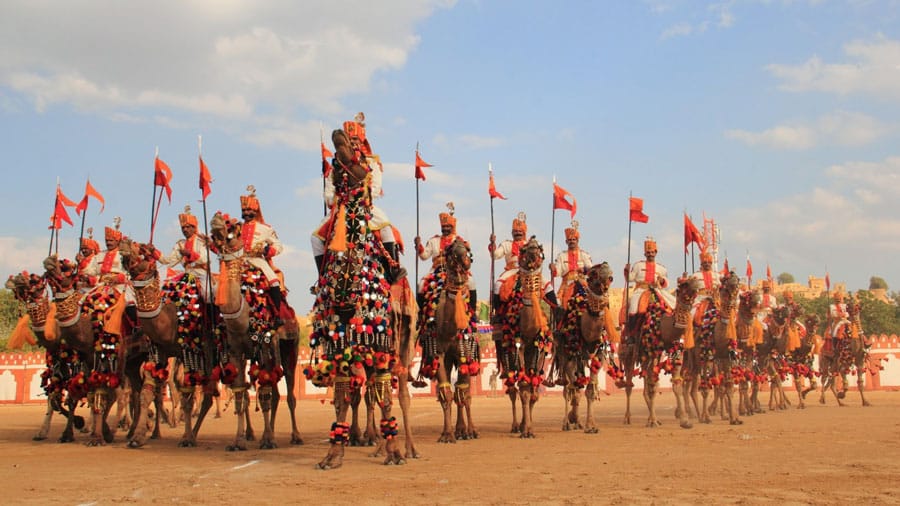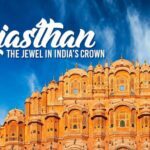The unique culture, customs, and way of life of people who live in desert areas are celebrated at desert festivals. These festivals give visitors a chance to experience the music, dance, art, and food of these communities as well as a glimpse into their extensive history and heritage. Some of the most vibrant and colorful desert festivals in the world are held in India, which draws people from all over the world. These festivals, from the Pushkar Camel Fair in Rajasthan to the Jaisalmer Desert Festival in Rajasthan, highlight the splendor and variety of India’s desert regions. In this blog, we will examine the history, distinctive characteristics, and significance of Indian desert festivals.
History of Desert Festivals in India
The nomadic lifestyle of the people who lived in the deserts can be seen in the history of desert festivals in India. Agriculture, animal husbandry, and trade have long provided for these communities, like those in Rajasthan’s Thar Desert. They accumulated a unique cultural heritage over time, which they would display and celebrate at festivals.
The Pushkar Camel Fair was one of India’s earliest desert festivals, going back more than 400 years. This annual fair started out as a place to trade camels, horses, and other livestock. Over time, it became a major cultural and tourist event that brought people from all over the world.

The Jaisalmer Desert Festival, which began in the 1980s to promote tourism in the area, is another well-known desert festival in India. Traditional dance and music performances, camel rides, turban-tying competitions, and other activities make up this festival, which celebrates the rich cultural heritage of the Rajasthan desert.
Millions of people come to India every year to attend desert festivals, which have grown to be an important part of Indian culture. They are not only fun and entertaining, but they also help to preserve the rich cultural traditions and heritage of the people who live in these areas.
Popular Desert Festivals in India
There are a number of well-known desert festivals in India that highlight the country’s extensive cultural heritage. The following are some of India’s most well-known desert festivals:
Jaisalmer Desert Festival: One of India’s most well-known desert festivals, the Jaisalmer Desert Festival is held every year in Jaisalmer, Rajasthan. Traditional music and dance performances, turban-tying competitions, and Camel races are among the cultural offerings at this festival.

Pushkar Camel Fair: One of India’s oldest desert festivals, the Pushkar Camel Fair is held every year in the Rajasthani town of Pushkar. The Camel Trade, in which thousands of camels are brought together for sale or trade, has made this festival famous. The festival includes cultural events like horse riding competitions and music and dance performances in addition to the Camel trade.

Rann Utsav: One of India’s largest desert festivals is the Rann Utsav, which takes place each year in the Rann of Kutch in the state of Gujarat. Traditional music and dance performances, cultural exhibits, and adventure activities like hot air balloon rides and camel safaris make this festival a one-of-a-kind opportunity to experience the Rann culture and beauty.

Nagaur Fair: One of India’s largest cattle fairs, the Nagaur Fair is held annually in the city of Nagaur in Rajasthan. Camel trading is a highlight of this festival, which also includes cultural events like music and dance performances and tug-of-war and horse riding competitions.

These are just a few examples of India’s well-known desert festivals. These festivals not only give visitors a glimpse into the rich cultural heritage of India’s desert regions, but they also let them experience the distinctive way of life and customs of the locals.
Unique Features of Desert Festivals in India
India’s desert festivals are renowned for their vibrant and colorful celebrations that highlight the distinctive culture and traditions of the locals. These festivals stand out for a variety of reasons, including:
Traditional and cultural activities: Music and dance competitions, turban-tying competitions, and traditional games are just a few of the cultural and traditional activities that are featured at Indian desert festivals. Visitors can get a taste of the local customs and traditions as well as gain insight into the region’s extensive cultural heritage through these activities.

Performances of art, music, and dance: In India, desert festivals feature art, music, and dance, all of which serve as venues for local performers and artists to demonstrate their skills. These festivals provide a wide range of cultural experiences, ranging from contemporary dance performances to traditional folk music from Rajasthan.
Food stalls and local cuisine: Indian desert festivals are also well-known for their food stalls and local cuisine, which allow visitors to sample the region’s distinctive and flavorful dishes. These festivals are a feast for the senses, with everything from sweets from the past to spicy street food.

Adventure sports: Desert festivals in India offer a variety of adventure activities in addition to cultural ones, like camel rides, sandboarding, and hot air balloon rides. Visitors can get a different and exciting perspective on the desert landscape through these activities.
These are just a few examples of the distinctive aspects of Indian desert festivals. These festivals are a must-see for anyone interested in learning about India’s rich cultural heritage because they provide a one-of-a-kind experience that highlights the country’s desert regions’ beauty and diversity.
Significance of Desert Festivals for Local Communities
Because they provide a platform for these communities to showcase their rich cultural heritage and traditions, desert festivals are of great significance to the local communities in India’s desert regions. These festivals benefit local communities in a number of ways, including:
Preservation of culture: By providing a stage for the presentation of traditional forms of music, dance, and art, desert festivals aid in the preservation of the community’s extensive cultural heritage. These festivals ensure that future generations will have the opportunity to experience and learn about these regions’ cultural traditions.

Economic advantages: Due to the influx of thousands of visitors from all over the world, desert festivals also significantly boost the local economies. This helps to support the local economy, create jobs, and bring in more customers for local businesses and vendors.
Increasing tourism: Desert festivals aid in the promotion of tourism to desert regions by showcasing the region’s unique traditions and rich cultural heritage. This not only helps the economy, but it also helps people learn about the special and important cultural heritage of these areas.

Bringing together communities: Additionally, desert festivals play a crucial role in bringing communities together and fostering a sense of belonging. People can come together to celebrate their common heritage at these festivals, which also help to strengthen relationships within the community.
In conclusion, desert festivals are an important part of preserving India’s rich cultural heritage and play an important role in the lives of local communities in the desert regions. As a significant and valuable part of the local culture and traditions, these festivals bring communities together, encourage tourism, and provide economic benefits.
Conclusion
The vibrant and extensive cultural heritage of India’s desert regions is celebrated at desert festivals. These festivals provide visitors with a one-of-a-kind and exciting experience, which ranges from traditional and cultural activities to performances of music, dance, and art. The local communities benefit greatly from the festivals as well, as they help to preserve cultural heritage, increase tourism, and cultivate a sense of community and belonging. Desert festivals are a must-see if you want to see the unique beauty and variety of India’s desert regions or just learn more about the country’s rich cultural heritage. Therefore, the next time you are in India, make sure to add a desert festival to your travel itinerary if you want to have an experience that is truly one-of-a-kind and memorable.
FAQs
When do Indian desert festivals take place?
The majority of desert festivals in India take place during the winter, from November to February, when visitors can enjoy cooler temperatures.
Where can I find information regarding Indian desert festivals?
Numerous travel websites, as well as the websites of local tourism boards and government agencies, offer information about Indian desert festivals.
How can I get to the Indian desert festivals?
The majority of major cities in India have airports that are well connected to the desert regions, making flying to the desert festivals the simplest mode of transportation. You can also get to the festivals by train or road, but this may not be as convenient and may take longer.
What should I bring to an Indian desert festival?
It is essential to bring lightweight, comfortable footwear and sun protection—such as a hat, sunglasses, and sunscreen—when packing for an Indian desert festival. To ensure that you stay hydrated and energized throughout the festival, you might also want to bring a camera and additional batteries.
What kind of activities can I expect to see at a desert festival in India?
You can anticipate participating in a wide range of cultural and traditional activities at an Indian desert festival, including turban-tying competitions, music and dance performances, and traditional games. You might also get the chance to go on adventure activities like camel rides and sandboarding, try the local food, and look for souvenirs.







